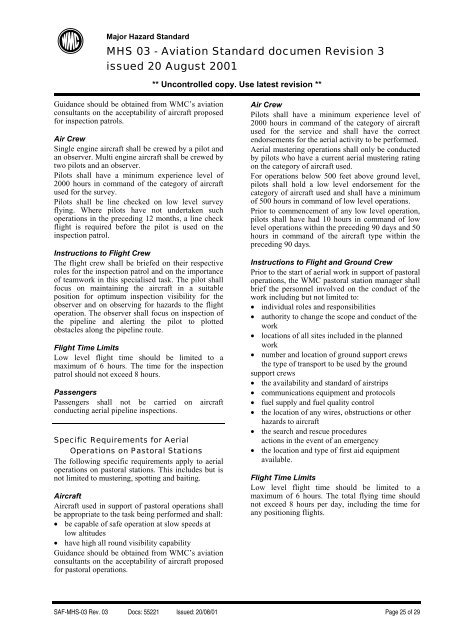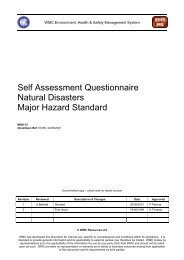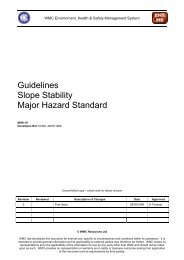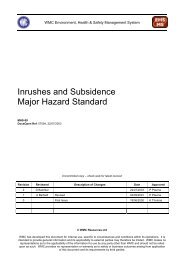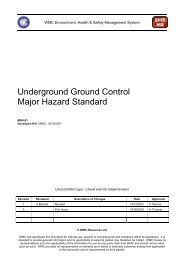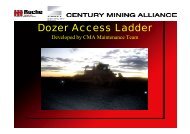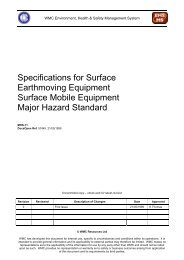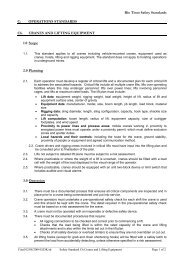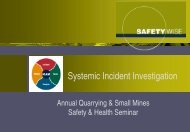Aviation Major Hazard Standard - MIRMgate
Aviation Major Hazard Standard - MIRMgate
Aviation Major Hazard Standard - MIRMgate
Create successful ePaper yourself
Turn your PDF publications into a flip-book with our unique Google optimized e-Paper software.
<strong>Major</strong> <strong>Hazard</strong> <strong>Standard</strong><br />
MHS 03 - <strong>Aviation</strong> <strong>Standard</strong> documen Revision 3<br />
issued 20 August 2001<br />
** Uncontrolled copy. Use latest revision **<br />
Guidance should be obtained from WMC’s aviation<br />
consultants on the acceptability of aircraft proposed<br />
for inspection patrols.<br />
Air Crew<br />
Single engine aircraft shall be crewed by a pilot and<br />
an observer. Multi engine aircraft shall be crewed by<br />
two pilots and an observer.<br />
Pilots shall have a minimum experience level of<br />
2000 hours in command of the category of aircraft<br />
used for the survey.<br />
Pilots shall be line checked on low level survey<br />
flying. Where pilots have not undertaken such<br />
operations in the preceding 12 months, a line check<br />
flight is required before the pilot is used on the<br />
inspection patrol.<br />
Instructions to Flight Crew<br />
The flight crew shall be briefed on their respective<br />
roles for the inspection patrol and on the importance<br />
of teamwork in this specialised task. The pilot shall<br />
focus on maintaining the aircraft in a suitable<br />
position for optimum inspection visibility for the<br />
observer and on observing for hazards to the flight<br />
operation. The observer shall focus on inspection of<br />
the pipeline and alerting the pilot to plotted<br />
obstacles along the pipeline route.<br />
Flight Time Limits<br />
Low level flight time should be limited to a<br />
maximum of 6 hours. The time for the inspection<br />
patrol should not exceed 8 hours.<br />
Passengers<br />
Passengers shall not be carried on aircraft<br />
conducting aerial pipeline inspections.<br />
Specific Requirements for Aerial<br />
Operations on Pastoral Stations<br />
The following specific requirements apply to aerial<br />
operations on pastoral stations. This includes but is<br />
not limited to mustering, spotting and baiting.<br />
Aircraft<br />
Aircraft used in support of pastoral operations shall<br />
be appropriate to the task being performed and shall:<br />
• be capable of safe operation at slow speeds at<br />
low altitudes<br />
• have high all round visibility capability<br />
Guidance should be obtained from WMC’s aviation<br />
consultants on the acceptability of aircraft proposed<br />
for pastoral operations.<br />
Air Crew<br />
Pilots shall have a minimum experience level of<br />
2000 hours in command of the category of aircraft<br />
used for the service and shall have the correct<br />
endorsements for the aerial activity to be performed.<br />
Aerial mustering operations shall only be conducted<br />
by pilots who have a current aerial mustering rating<br />
on the category of aircraft used.<br />
For operations below 500 feet above ground level,<br />
pilots shall hold a low level endorsement for the<br />
category of aircraft used and shall have a minimum<br />
of 500 hours in command of low level operations.<br />
Prior to commencement of any low level operation,<br />
pilots shall have had 10 hours in command of low<br />
level operations within the preceding 90 days and 50<br />
hours in command of the aircraft type within the<br />
preceding 90 days.<br />
Instructions to Flight and Ground Crew<br />
Prior to the start of aerial work in support of pastoral<br />
operations, the WMC pastoral station manager shall<br />
brief the personnel involved on the conduct of the<br />
work including but not limited to:<br />
• individual roles and responsibilities<br />
• authority to change the scope and conduct of the<br />
work<br />
• locations of all sites included in the planned<br />
work<br />
• number and location of ground support crews<br />
the type of transport to be used by the ground<br />
support crews<br />
• the availability and standard of airstrips<br />
• communications equipment and protocols<br />
• fuel supply and fuel quality control<br />
• the location of any wires, obstructions or other<br />
hazards to aircraft<br />
• the search and rescue procedures<br />
actions in the event of an emergency<br />
• the location and type of first aid equipment<br />
available.<br />
Flight Time Limits<br />
Low level flight time should be limited to a<br />
maximum of 6 hours. The total flying time should<br />
not exceed 8 hours per day, including the time for<br />
any positioning flights.<br />
SAF-MHS-03 Rev. 03 Docs: 55221 Issued: 20/08/01 Page 25 of 29


